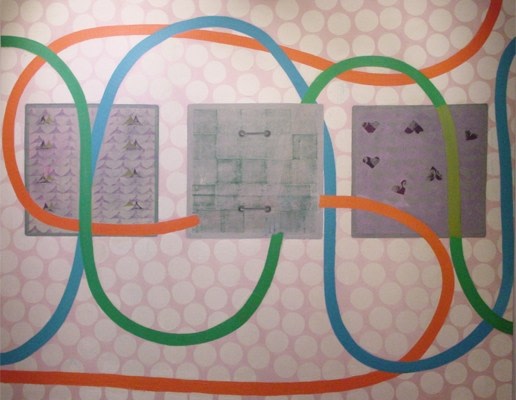
Anjum Singh's 'All that Glitter is Litter' held at Delhi's Vadehra Art Gallery between the 17th of January and the 9th of February looked at how in the urban jungle the natural had given way to the synthetic. The burgeoning city beset by manifold ills has been an ongoing preoccupation of Singh's Big city blues, as evidenced in the growing mounds of garbage, the unending traffic jams, the lack of drinking water and civic amenities have all been grist for the artist's mill. For a long time now, she has looked behind the glamorous glass facades of the malls and the hypermarts and questioned their artificiality.
A gigantic pink flower, its petals made of empty cola bottles painted pop pink sprang out from a green Astroturf carpet in Char Babar. It was a work that one had seen in earlier avatars - Cola Bloom made during the Khoj International Artists' workshop in 2001 where it nestled in the verdant green grounds of Sikribagh was later installed in Delhi's Palette Art Gallery. For Singh, it has been as much about 'perfecting' this work over the years as about translating the organic into inorganic terms. Playing a role in this cross-pollination was another work titled Buzz... It recalled the gigantic beehives that one espied stuck to monuments or buildings given the paucity of natural habitats in urban contexts. Here, shiny oblong magnets clustered together on armatures, mimicking hives. The installation reminded you of industrious workers that are the life force of every city and their oil and tenacity, which is harnessed to transform the dreams of urban planners.
It was the lack of an alternate plan that the artist bemoaned in her exhibition. She questioned the 'India Shining' campaign pointing to the utter disregard that inhabitants of the city showed to its public spaces. Nowhere was this illustrated as well as in her canvas works Spit and Spat where she drew the contours of the city besmirched with cigarette stubs and betel nut stains. In doing so, she underlined the disconnect between the people and the city they reside in.
Could this be because they feel they have no stake in the transformation that is taking place around them? In the run-up to the Commonwealth Games in Delhi, trees are being lopped off and uprooted to make way for new metro lines and bus corridors stripping the capital city of its green cover. Opposition is ridden over roughshod and alternate views seldom sought. It is within this context that a work like Minim needs to be understood- Singh created an enchanted forest using industrial materials like aluminum and Perspex. In this futuristic landscape, the transformation of the organic into the inorganic seemed to be complete. It was a world where avarice had paved the path for artifice.
In a cheeky aside, Singh also decided to aestheticize the detritus of the city. She made a pile of garbage posh and pretty by sanitizing it. The work reminded you of Vivan Sundaram's works, which explore the aesthetics of waste. Unlike Sundaram, who physically transported waste into the white cube, Singh created her own version of garbage with bright bits of acrylic. Sundaram raised a number of social and political issues related to waste and dwelt on the dynamics of the waste/high art equation. By showing us how waste can mimic high art and high art can degenerate into waste, Sundaram offered us new paradigms of engagement with the city. In contrast, Singh seemed to skim the surface, preferring to be all froth and light. She concentrated instead on the quirky Midas act by transforming all that glittered not into gold, but into litter.
-Meera Menezes